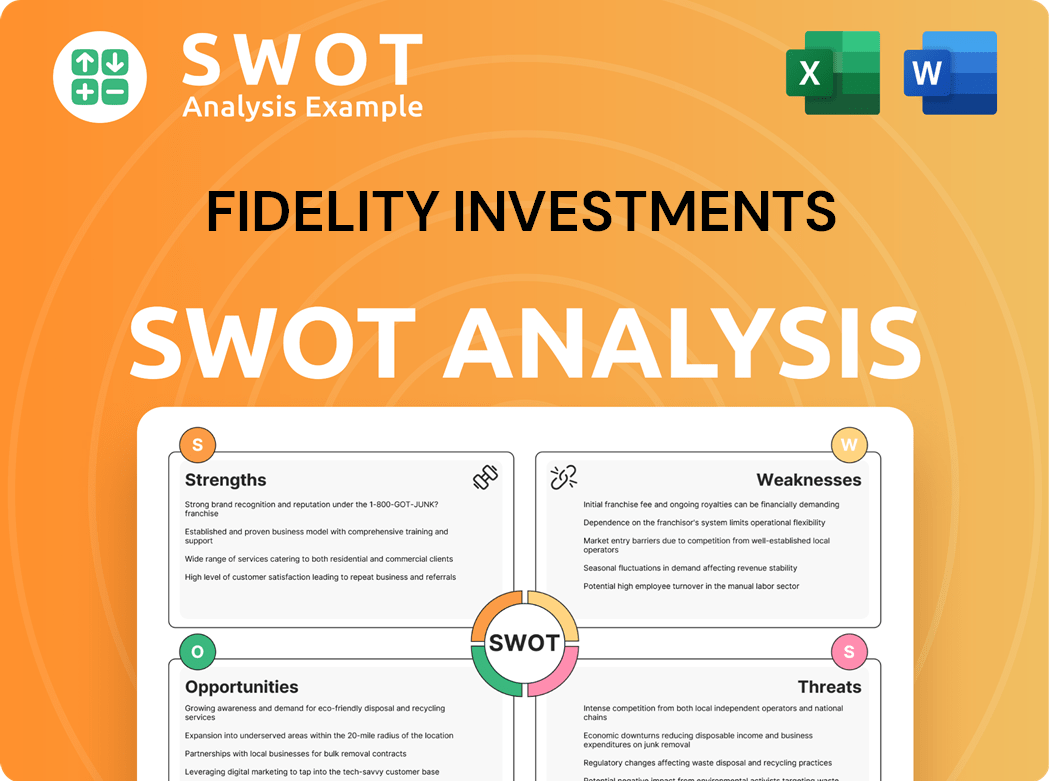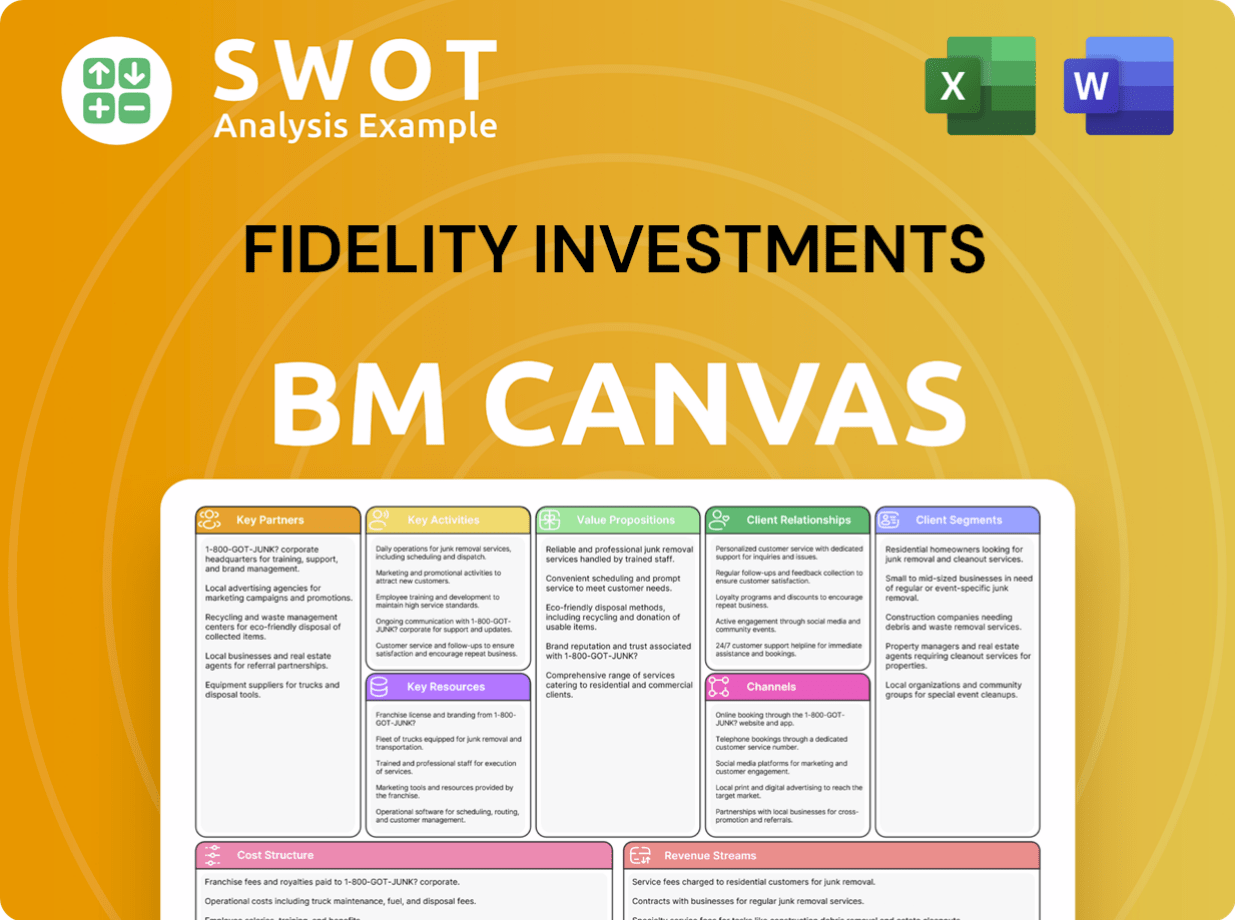Fidelity Investments Bundle
Unraveling the Ownership of Fidelity Investments: Who's Really in Charge?
Navigating the financial world often leads investors to Fidelity Investments, a titan in the industry. But have you ever wondered about the very foundation of this financial powerhouse? Understanding Fidelity Investments SWOT Analysis is crucial, but first, let's explore who truly owns and steers this massive enterprise.

The question of "Who owns Fidelity Investments?" is more than just a matter of curiosity; it's key to understanding the company's long-term strategy and priorities. Unlike many competitors, Fidelity's unique ownership structure, shaped by its history and key figures, sets it apart. This article will dive deep into Fidelity ownership, exploring its evolution from its founding to the present day, examining the influence of its leadership, and analyzing how this structure impacts its operations and strategic direction.
Who Founded Fidelity Investments?
The story of Fidelity Investments began in 1946 with Edward C. Johnson II. A lawyer by training, Johnson established Fidelity Management & Research Company (FMR) with a clear goal: to offer professional investment management services to a wider audience. This marked the beginning of what would become a financial powerhouse.
From the outset, the ownership of Fidelity Investments was closely held. Edward C. Johnson II held the primary stake, setting the stage for the company's future. The initial focus was on mutual funds, with the launch of the Fidelity Fund being a key early move.
Early ownership was largely confined to the Johnson family, solidifying the privately-held nature of the company, which continues today. While specific equity splits from the beginning aren't publicly available due to its private status, the Johnson family maintained significant control. There were no widely reported early investors outside the founding circle, reinforcing the family-centric ownership model.
The early agreements likely focused on securing the family's control and ensuring the long-term vision of the firm. This approach has been central to how Fidelity Investments has operated. The founding team's vision of long-term investment and client focus was deeply embedded in this controlled distribution of ownership.
- Who owns Fidelity: The Johnson family has maintained significant control since the beginning.
- Fidelity ownership: The ownership structure has remained largely within the Johnson family.
- Fidelity parent company: Fidelity Management & Research Company (FMR) was the initial parent company.
- Fidelity shareholders: The primary shareholders were members of the Johnson family.
Fidelity Investments SWOT Analysis
- Complete SWOT Breakdown
- Fully Customizable
- Editable in Excel & Word
- Professional Formatting
- Investor-Ready Format

How Has Fidelity Investments’s Ownership Changed Over Time?
The ownership of Fidelity Investments, a financial powerhouse, has been predominantly shaped by the Johnson family, maintaining its private status. This structure has allowed the company to navigate the financial landscape with a long-term perspective, unlike many of its publicly traded competitors. The leadership transitions within the Johnson family have been pivotal, with Edward C. Johnson III taking over in 1977 and Abigail Johnson assuming the CEO role in 2014, later becoming Chairman in 2016, thus solidifying the family's control. This succession has been key in defining the firm's strategic direction and governance, ensuring continuity in its operational philosophy.
The evolution of Fidelity's ownership reflects a deliberate strategy to remain private, which has enabled it to prioritize long-term investments and innovation. The Johnson family's continued stewardship has been crucial in maintaining this approach. The company's history is marked by strategic decisions that have allowed it to expand its offerings and adapt to market changes. The current ownership structure, with the Johnson family holding a substantial majority of voting shares and employees owning a significant minority, underscores a commitment to long-term value creation. This approach has also influenced its ability to make strategic investments in technology and expand into new markets without the pressures of short-term shareholder expectations.
| Key Event | Impact | Year |
|---|---|---|
| Edward C. Johnson III Takes Leadership | Expanded firm's reach and offerings | 1977 |
| Abigail Johnson Becomes CEO | Solidified family control and long-term strategy | 2014 |
| Abigail Johnson Becomes Chairman | Reinforced family's influence | 2016 |
As of 2024, the Johnson family's ownership is estimated to be around 49%, with employees holding a significant minority stake. This structure allows for strategic investments and a focus on long-term growth. The company's private ownership model has enabled it to make strategic investments without the constant scrutiny of public shareholders. This approach has fostered a more patient and long-term approach to growth and innovation. Learn more about the Growth Strategy of Fidelity Investments.
Fidelity Investments is primarily owned by the Johnson family, maintaining its status as a privately held company. The ownership structure allows Fidelity to focus on long-term strategies and innovation. The Johnson family controls a substantial majority of the company's voting shares.
- The Johnson family controls a substantial majority of Fidelity.
- Employees hold a significant minority stake.
- Fidelity remains a private company, unlike many competitors.
- Abigail Johnson is the current Chairman, representing the third generation of family leadership.
Fidelity Investments PESTLE Analysis
- Covers All 6 PESTLE Categories
- No Research Needed – Save Hours of Work
- Built by Experts, Trusted by Consultants
- Instant Download, Ready to Use
- 100% Editable, Fully Customizable

Who Sits on Fidelity Investments’s Board?
The Board of Directors at Fidelity Investments, also known as FMR LLC, reflects its unique ownership structure. The controlling Johnson family holds significant representation on the board. While a comprehensive public list of all board members isn't available due to the company's private status, it's known that key positions are held by members of the Johnson family. Abigail Johnson, for instance, serves as Chairman and CEO. Other board members likely include senior executives from within the company and potentially a limited number of independent directors, although their specific roles and affiliations aren't publicly disclosed, unlike a publicly traded company.
The governance of Fidelity Investments is heavily influenced by the Johnson family's concentrated voting power. This family holds the majority of the voting shares, which gives them substantial control over strategic decisions, executive appointments, and the overall direction of the company. This concentration of voting power is a defining characteristic of Fidelity's governance model. Unlike public companies, Fidelity's private ownership structure largely insulates it from external pressures such as proxy battles or activist investor campaigns. This allows the company to focus on long-term strategies without the immediate demands of public shareholders, shaping decision-making by enabling a more consistent and family-driven vision for the firm's future. The tightly controlled ownership and voting structure have resulted in no widely reported proxy battles or governance controversies significantly impacting Fidelity's decision-making process.
Understanding the structure of Fidelity ownership is key to grasping its operations. The Johnson family's control is central to the company's governance. For more insights into how Fidelity generates revenue, consider exploring Revenue Streams & Business Model of Fidelity Investments.
- The Johnson family holds the majority of voting shares.
- Abigail Johnson is the Chairman and CEO.
- The private structure allows for long-term strategic focus.
- Fidelity is not subject to the same pressures as public companies.
Fidelity Investments Business Model Canvas
- Complete 9-Block Business Model Canvas
- Effortlessly Communicate Your Business Strategy
- Investor-Ready BMC Format
- 100% Editable and Customizable
- Clear and Structured Layout

What Recent Changes Have Shaped Fidelity Investments’s Ownership Landscape?
In recent years, Fidelity Investments has maintained its private ownership structure, focusing on strategic growth and adapting to market changes. Unlike public companies, there have been no significant share buybacks or secondary offerings. Instead, Fidelity has expanded organically and through strategic acquisitions, such as its investments in digital asset offerings, including cryptocurrency services. This approach reflects a commitment to long-term strategic initiatives rather than short-term shareholder pressures.
The Johnson family's continued control over Fidelity ensures that the company can navigate industry trends, such as increased institutional ownership and activist investors, without the same pressures as publicly traded firms. The private ownership model allows Fidelity to prioritize client-centric innovation and long-term growth strategies. This includes ongoing investments in technology and the expansion of advisory services, allowing it to remain competitive in the evolving financial landscape. As of late 2024, the company's focus remains on these strategic priorities, with no public announcements regarding changes to its ownership structure.
| Aspect | Details | Status |
|---|---|---|
| Ownership Structure | Private | Maintained |
| Key Shareholders | Johnson Family | Continued Control |
| Strategic Focus | Long-term growth, client-centric innovation | Ongoing |
Fidelity Investments is privately held, primarily controlled by the Johnson family. This structure allows for a focus on long-term strategies. The private ownership insulates the company from the pressures of public markets.
Fidelity has expanded into digital assets and other technologies. There have been no significant changes in ownership structure. The company continues to focus on organic growth and strategic acquisitions.
Private ownership allows Fidelity to prioritize client needs. It also enables long-term strategic investments. This structure supports innovation and market adaptability.
The current leadership succession within the Johnson family suggests a commitment to maintaining the private ownership model. Fidelity is likely to continue investing in technology and expanding its services. The company aims to meet the evolving needs of its clients.
Fidelity Investments Porter's Five Forces Analysis
- Covers All 5 Competitive Forces in Detail
- Structured for Consultants, Students, and Founders
- 100% Editable in Microsoft Word & Excel
- Instant Digital Download – Use Immediately
- Compatible with Mac & PC – Fully Unlocked

Related Blogs
- What are Mission Vision & Core Values of Fidelity Investments Company?
- What is Competitive Landscape of Fidelity Investments Company?
- What is Growth Strategy and Future Prospects of Fidelity Investments Company?
- How Does Fidelity Investments Company Work?
- What is Sales and Marketing Strategy of Fidelity Investments Company?
- What is Brief History of Fidelity Investments Company?
- What is Customer Demographics and Target Market of Fidelity Investments Company?
Disclaimer
All information, articles, and product details provided on this website are for general informational and educational purposes only. We do not claim any ownership over, nor do we intend to infringe upon, any trademarks, copyrights, logos, brand names, or other intellectual property mentioned or depicted on this site. Such intellectual property remains the property of its respective owners, and any references here are made solely for identification or informational purposes, without implying any affiliation, endorsement, or partnership.
We make no representations or warranties, express or implied, regarding the accuracy, completeness, or suitability of any content or products presented. Nothing on this website should be construed as legal, tax, investment, financial, medical, or other professional advice. In addition, no part of this site—including articles or product references—constitutes a solicitation, recommendation, endorsement, advertisement, or offer to buy or sell any securities, franchises, or other financial instruments, particularly in jurisdictions where such activity would be unlawful.
All content is of a general nature and may not address the specific circumstances of any individual or entity. It is not a substitute for professional advice or services. Any actions you take based on the information provided here are strictly at your own risk. You accept full responsibility for any decisions or outcomes arising from your use of this website and agree to release us from any liability in connection with your use of, or reliance upon, the content or products found herein.